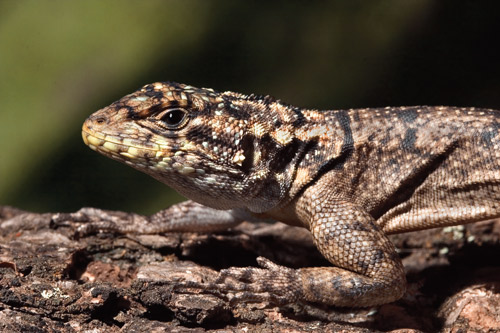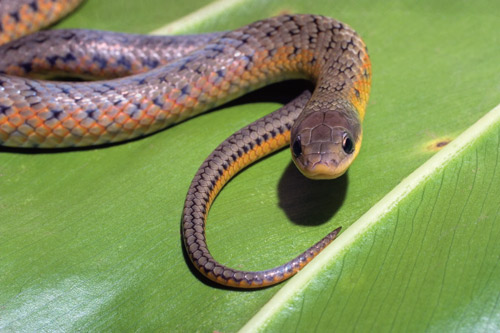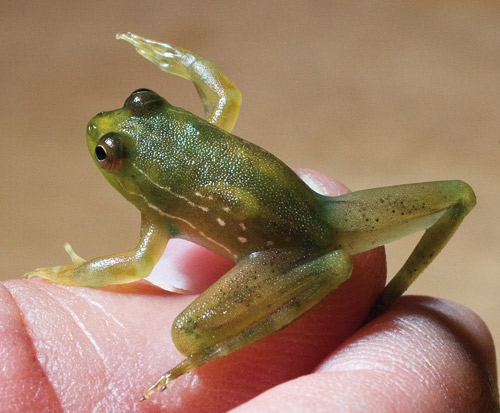The largest freshwater wetland in the world lies near the center of South America in the Upper Paraguay River Basin, at the border of Bolivia, Paragua
The largest freshwater wetland in the world lies near the center of South America in the Upper Paraguay River Basin, at the border of Bolivia, Paraguay and Brazil. The Matto Grosso is a 95,000-square-mile marshland that is both unique and ecologically significant. It sustains incredible biodiversity because of its isolated location: the convergence of the Atlantic rain forest, Amazon forest, Brazilian savannah, Castinga and Paraguayan Chaco biomes. The Brazilian portion makes up 80 percent and is contained within the states of Matto Grosso and Matto Grosso do Sul. It is 98 percent privately owned. The southeastern one-third of this 59,000-square-mile marshland is designated as the Pantanal.
Ecotourism in South America
The opportunity to observe the wide selection of distinctive amphibians and reptiles is what attracted our tour group. Having had great success with arranging similar herp-oriented trips to other parts of South America, I contacted the ecotourism company International Expeditions (IE).

Photo by Manny Rubio
As luck would have it, the owner and biologists at the premiere facility in the Pantanal, Refugio Ecologico Caiman, were interested in having the herpetofauna of the 20,000-acre preserve surveyed. We would be given nearly free reign of the facility. The ranch is on the southeastern border of the Pantanal and would appear to be greatly influenced by the adjacent herp-rich Atlantic rain forest biome. After nearly two years of preparation, the trip was set for the end of the rainy season. The seasons are reversed in the Southern Hemisphere, so we went in the last part of March. This time frame was chosen to coincide with the conclusion of most reptile birthing and hatching, receding water levels and dispersal of wildlife. Also, the numbers of mosquitoes and other insidious insects would hopefully be ebbing.

Photo by Manny Rubio
The foot-long Polychrus acutirostris rarely descends from among the tall trees of the canopy. This one was found on a palm tree adjacent to a semi-flooded grassland.
It was relatively easy to bring together several experienced field biologists, herpetologists and naturalists from previous outings as part of the group of 17 people. This was the maximum number that could be accommodated at the Sede Lodge, Seda da Fazenda.
Members of our group were leaving from five cities with plans of meeting in Sao Paulo, Brazil, spending the night and continuing the next morning. A wildcat air traffic controllers’ strike in Sao Paulo canceled flights and left most of us stranded for a day or two. Needless to say, the trip was exceptionally long and laborious; we endured a 14-hour flight time to Sao Paulo, another two-hour one to Campo Grande, plus connection time for two airplane changes. All of this was followed with a nearly four-hour, 160-mile drive by van to the ranch, one-fourth of which was over dirt roads.
We knew from previous IE trips to isolated locales that our accommodations would be comfortable. To our surprise, the lodge was a deluxe facility, a genuine oasis in the midst of a huge, spectacular swamp. During our stay, we found it a welcomed pleasure to return to our rooms from a day in the field. We certainly were not roughing it!
Campo Grande Brazil
Early the first morning we boarded two large, open-sided trucks. They were our transportation while at the preserve and easily negotiated the labyrinth of dirt roads that doubled as dikes and passageways around the seasonally flooded fields. Each truck had a naturalist/spotter/driver and one or two of the preserve’s biologists.
Our introduction to herps started immediately with an extensive gathering of several dozen Caiman yacare sunning along the edges of a pond and waterway close to the lodge. A handful of larger caiman were lying in the water at the base of a miniature cascade, allowing the water to flow through their gaping mouths. They were patiently awaiting a meal of any aquatic animal luckless enough to be carried by the torrent.

Photo by Manny Rubio
Simplistically beautiful and variably colored, mildly venomous Liophis poecilogyrus is the common Pantanal equivalent of North American garter snakes.
It was immediately apparent that the preserve’s biologists have an incredible ability to see wildlife, but they are attuned to specific places that harbor the birds and mammals most visitors want to see. Herp microhabitat was new to them. We spent most of the day touring the facility, asking questions and pointing out the types of places we would like to locate. To avoid the intense sun and stifling humidity, daytime searching was limited to the morning and late afternoon. We anticipated that driving the roads at night and wading through the endless marshes would be the most productive hunting methods.
Lack of a primary method of locating a large number of different species in a short period of time was a setback. There were practically no man-made habitats (piles of wood, abandoned buildings or trash) to attract and harbor herps. The ranch prides itself on a high level of maintenance and tidiness.
A Plentiful Day Two
The second day of hunting buoyed our expectations of it being a spectacular trip; we found a large female Crotalus durissus collilineatus stretched out, crossing an isolated dirt road. The perceptibly thin region toward the vent showed it was a female that had recently given birth, an indicator that the population is viable. None of us had ever seen this species before, and it was one of our major reasons for coming to the Pantanal. This was only the fourth rattlesnake ever found on the vast preserve and the only one ever seen alive. These rattlesnakes do not live in aquatic places; they inhabit high ground, which rarely, if ever, becomes inundated.

Photo by Manny Rubio
An immature specimen of the Tropidurus spp.
It took diligent searching and some luck to see the magnificently camouflaged Leptophis ahaetulla sitting motionless among the branches of a shrub. Before darting away into the brush, this arboreal snake responded by slowly waving its extended fore-body, emulating the plant moving in the breeze.
The diminutive coral snake mimic, Oxyrhopus petola, with its red, white and black bands, was easily the most brightly colored snake we encountered. The upturned snout of this frog-and-toad eater is an adaptation for burrowing, which enables its mostly fossorial lifestyle. It was surprising to find two within a few feet of each other crawling on a shaded sandy path mid-morning.
Only one of a dozen or so species of rear-fanged snakes known to be in the area, Leptodeira annulata is a familiar find on trips ranging from northern Mexico through Latin America to here in southern Brazil. Throughout its entire range this arboreal, nocturnal snake maintains a “nasty” disposition, striking at any annoyance within range. This common lizard-and-frog eater is relatively small and barely capable of envenomating humans.
Thamnodynastes chaquensis is another small snake with a propensity to strike. This blunt-faced snake varies widely in coloration from yellowish to brown and is equally at home on the ground or in shrubs. It also feeds primarily on frogs, as do the most of the snakes in the Pantanal. Nearly all the snakes were captured while cruising the dirt roads, typically at night.

Photo by Manny Rubio
Huge numbers of Pseudis limellum were seen hopping in most wet grassy places. Although it looks like a small hylid, it is currently in the same genus as the paradox Frog, Pseudis paradoxa.
With the exception of the ubiquitous nocturnal Hemidactylus mabouia, lizards were diurnal. Surprisingly, Iguana iguana are rarely ever seen on the property; however, they are abundant on the other side of the nearby Aquidauana River. A few Dracaena paraguayensis were seen, usually from a distance as they crashed off into the underbrush. The caiman lizard is aptly named because of its semi-aquatic lifestyle and its thick, tough leathery body scales that are very similar to a crocodilian’s. It is unique in that it is a specialized feeder. Massive jaws and molarlike teeth enable it to crush the shells of its primary food, escargot-sized snails that are considered by some biologists to be the primary biomass of the Pantanal.
Most of the other lizard species there are considerably smaller and rarely leave the safety of shrubbery and trees. Like the various species of Sceloporus that most of us are familiar with throughout North America, Tropidurus torquatus is typically seen as little more than a glance as it scurries along branches, a fallen log or up a tree. We were fortunate to capture one of the more interesting and unique lizard species that normally lives in the canopy: Polychrus acutirostris. It demonstrates actions and a primary characteristic of Old World chameleons. Along with a slow, deliberate walking motion, it has turretlike eyes that can move in totally different directions.
Chelonians of South America
Turtles and tortoises were also out during the day. Because of the richness of the environment, aquatic turtles must be incredibly abundant there, but they, too, were easily engulfed by the overwhelming habitat. In most other places they are caught by fisherman, but fishing is not permitted in the preserve, so our observations were minimal. Two closely related side-necked species, Acanthochelys macrocephala and Phrynops geoffroanus, were observed wandering through shallow water.
A creature that always seems out of place in predominately wet habitats through much of South America is Geochelone carbonaria. Two large ones were found foraging on high ground on separate mornings. One must have a burrow in especially abrasive soil, because the distinctive carapace scute rings were worn smooth.
Frogs of South America
Metamorphosing and adult frogs were almost everywhere. They were plentiful in certain places but tended to be in colonies of one species. The largest numbers were seen at night by flashlight as we sloshed through plant-choked wet places. One wide-ranging treefrog, Hypsiboas raniceps, was difficult to identify, because it was found in several subadult sizes and changed color very rapidly from green to yellow or tan and every hue in between. Unlike most North American hylids, several genera and species here are drably colored, almost patternless and mostly nondescript. Two small species fitting this description are the rugous-skinned Scinax nasicus and the sexually dimorphic S. fuscovarius. Toward the other end of the hylid size spectrum is Trachycephalus venulosus. Easily described as a handful, this frog provides anyone foolish enough to hold it with an unpleasant glob of mucus that is very difficult to wash off.
The most commonly encountered frog was Lysapsus limellus, a very small relative of the mostly aquatic Pseudis platensis. Great numbers of the former were observed wherever there was moisture. Several jumped in all directions in response to each step we took into the low, water-based foliage.
As anticipated, with their expansive distribution and number of species throughout Central and South America, we saw several leptodactylids hopping and foraging in most of the inundated places. Aside from different species of the complex genus Physalaemus, none were observed in large numbers. This faction is in need of study and will likely be broken into several species. One recently described Pantanal form is P. centralis. Apparently, most of the leptodactylids had dispersed and would not aggregate to breed until the next rainy season. We found adult and subadult Leptodactylus elenae, L. chaquensis, L. podicipinus and L. bufonius. The body shape of the latter closely resembles that of bufonid toads and is the reason for its specific name.
At one point, the truck’s headlights exposed a squat, massive anuran lumbering across the dirt road. Closer inspection proved it to be Rhinella schneideri. Other herpetologists frequently assign it as R. paracnemis. Regardless, the large, bloating body; huge, oozing parotid glands; deep, resonating warning clucks; and copious voiding of water let us know it was a male that did not want to be handled.
Elachistocleis bicolor is a minute microhylid with bright yellow “flash coloration” on the inside of its rear thighs and lower-neck region. This fossorial ant-and-termite eater was occasionally found under pieces of wet ground litter.
A brief shower one night brought the darkness to life with a flourish of unidentifiable frog sounds. This short-lived sampling initiated fantasies of the cacophony produced by thousands of frogs that aggregated to call and breed in the swelling marshes a few months earlier at the beginning of the rainy season.
Protecting the Pantanal
Some of the Pantanal’s modern-thinking land barons concerned about their natural heritage are making strides to protect the environment and its distinctive wildlife by retaining large parcels as natural preserves. The protected areas are mostly isolated, fenced parts of huge ranches that supply the money to help fund the conservation effort. Practically none of the land has been cleared during the past 200 years, because natural grazing areas are extensive. To further support conservation, the owners have actively embraced ecotourism. Scientists believe that hundreds, if not thousands, of new forms of flora and fauna await discovery and description. The Pantanal has a great deal to offer those who appreciate nature.
Sample, Don’t Collect
The Brazilian government stringently enforces laws that protect its wildlife from being collected and exported. Permits are almost impossible to acquire, and even Brazilian zoos and institutions have great difficulty getting them. We were prepared to process all of our voucher specimens with photographs and release them. There was no need to handle more than one animal from an exact location.
Sampling was simple but time consuming. When an animal was found, it was sequentially numbered, GPS coordinates were recorded and the animal was photographed with a high-resolution digital camera. Several poses showing important characteristics were taken. Still, back in the United States identification would prove more difficult than expected, because there are no contemporary keys and descriptions, and associated data on most species are published in obscure, difficult-to-locate journals in many languages. Very few of the herps have been in live collections, and in many cases, taxonomic reassignments and misidentified preserved specimens have kept them in a state of flux for generations.
For our group, the Pantanal’s lure certainly was not fulfilled, it was whetted. Now we have a new incentive, a motivation to a return in a different season to discover a myriad of species that are acknowledged only as illustrations and descriptions in a growing stack of herpetological literature.



